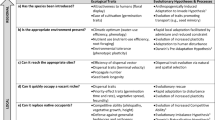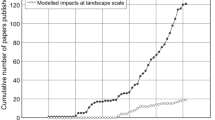Abstract
Invaders, weeds and colonizers comprise different but overlapping sets of species. The probability of successful invasion is low. The 10:10 rule state that 10% of introduced speices (those with feral individuals) become established, 10% of established species (those with self-sustaining populations) become pests. The rule gives an adequate fit to British plant data. The rule predicts that invaders will be rarer than natives. This is shown for British Anatidae. There is a continuous spectrum of perceived weediness. Although this spectrum is significantly related to Baker characters, neither those characters or any others can usefully predict which species will be weeds over a wide range of species. Characters tuned to sets of closely related species shown more promise. A study of BritishImpatiens shows that the characters responsible for critical ecological behaviour are still obscure. Small genetic changes can cause large ecological changes. GMOs will have characters entirely new to that species' evolutionary history. While most will have little ecological effect, a few may be ecologically and economically damaging. A sensible programme of field trials and monitoring is justified to minimize the risk.
Similar content being viewed by others
References
Baker, H. G., Characteristics and modes of origin of weeds, in: The Genetics of Colonizing Species, pp. 147–172. Eds H. G. Baker and G. L. Stebbins. Academic Press, New York and London 1965.
Baker, H. G., The evolution of weeds. A. Rev. ecol. Syst.5 (1974) 1–24.
Beerling, D., and Perrins, J., Biological flora of the British Isles,Impatiens glandulifera. J. Ecol., in press.
Bradshaw, A. R., The Croonian Lecture, 1991. Genostasis and the limits to evolution. Phil. Trans. R. Soc. Lond.B 333 (1991) 289–305.
Clapham, A. R., Tutin, T. G., and Moore, D. M., Flora of the British Isles, 3rd edn. Cambridge University Press, Cambridge, England 1987.
Drake, J. A., Mooney, H. A., di Castri, F., Groves, R. H., Kruger, F. J., Rejmánek, M., and Williamson, M., Eds., Biological Invasions, a Global Perspective. SCOPE 37. John Wiley & Sons, Chichester and New York 1989.
Fitter, A., Perrins, J., and Williamson, M., Weed probability challenged. Bio/Technology8 (1990) 473.
Groves, R. H., Invasion of mediterranean ecosystems by weeds, in: Resilience in Mediterranean-type Ecosystems, pp. 129–145. Eds B. Dell, A. J. M. Hopkins and B. B. Lamont. Dr W. Junk Publishers, Dordrecht, Netherlands 1986.
Health and Safety Executive, Guide lines on work with transgenic animals. HSE/ACGM Note 10. Health and Safety Executive, London.
Holdgate, M. W., Summary and conclusions: characteristics and consequences of biological invasions. Phil. Trans. R. Soc. Lond.B 314 (1986) 733–742.
Hulten, E., Flora of Alaska and Neighbouring Territories. Stanford University Press, Stanford, California 1968.
Kirk, A. A., and Lumart, J.-P., The importation of mediterranean-adapted dung beetles (Coleoptera: Scarabidae) from the northern hemisphere to other parts of the world, in: Biogeography of Mediterranean Invasions, pp. 413–424. Eds R. H. Groves and F. di Castri. Cambridge University Press, Cambridge, England 1991.
Marchant, J. H., Hudson, R., Carter, S. P., and Whittington, P., Population Trends in British Breeding Birds. British Trust for Ornithology, Tring, England 1990.
Perring, F. H., and Walters, S. M., Atlas of the British Flora. Nelson, London 1962.
Perrins, J., Why is a weed a weed? D. phil. thesis University of York, York, England 1991.
Perrins, J., Fitter, A., and Williamson, M., Population biology and rates of invasion of three introducedImpatiens species in the British Isles. J. Biogeogr., in press.
Perrins, J., Williamson, M., and Fitter, A., A survey of differing views of weed classification: implications for regulation of introductions. Biol. Conserv.60 (1992) 47–56.
Perrins, J., Williamson, M., and Fitter, A., Do annual weeds have predictable characters? Acta oecol.13 (1992) 517–533.
Simberloff, D., and Boecklen, W., Patterns of extinction in the introduced Hawaiian avifauna: a re-examination of the role of competition. Am. Nat.138 (1991) 300–327.
Stace, C., New Flora of the British Isles. Cambridge University Press, Cambridge, England 1991.
Usher, M. B., Invasibility and wildlife conservation: invasive species on nature reserves. Phil. Trans. R. Soc. Lond.B 314 (1986) 695–710.
Williamson, M., Potential effects of recombinant DNA organisms on ecosystems and their components. Trends Ecol. Evol.3 (1988) S32-S35.
Williamson, M., Mathematical models of invasion, in: Biological Invasions, a Global Perspective (SCOPE 37), pp. 329–350. Eds J. A. Drake, H. A. Mooney, F. di Castri, R. H. Groves, F. J. Kruger, M. Rejmánek and M. Williamson. John Wiley & Sons, Chichester and New York 1989.
Williamson, M., Assessment of the hazards from genetically-engineered plants: the work of the Advisory Committee on Genetic Manipulation Intentional Introduction Sub-committee, in: Herbicide Resistance in Weeds and Crops: Long Ashton International Symposium 11, pp. 375–386. Eds J. C. Caseley, G. W. Cussans and R. K. Atkin. Butterworth Heinemann, London 1991.
Williamson, M., Biocontrol risks. Nature353 (1991) 354.
Williamson, M., Enviromental risks from the release of genetically modified organisms (GMOs) — the need for molecular ecology. Molec. Ecol.1 (1992) 3–8.
Williamson, M., and Brown, K., The analysis and modelling of British invasions. Phil. Trans. R. Soc. Lond.B314 (1986) 505–522.
Williamson, M., Perrins, J. and Fitter, A., Releasing genetically engineered plants: present proposals and possible hazards. Trends Ecol. Evol.5 (1990) 417–419.
Author information
Authors and Affiliations
Rights and permissions
About this article
Cite this article
Williamson, M. Invaders, weeds and the risk from genetically manipulated organisms. Experientia 49, 219–224 (1993). https://doi.org/10.1007/BF01923529
Published:
Issue Date:
DOI: https://doi.org/10.1007/BF01923529




